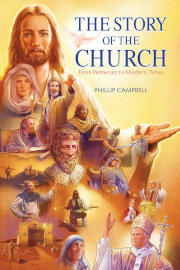The Story of the Church: From Pentecost to Modern Times is a Catholic church-history course for students in grades six through eight. The course consists of a textbook a workbook, an audiobook reading of the textbook, and streamed video lectures. The textbook is available in print or as a PDF. The workbook is only a printed product, and the audiobook is available either as MP3 downloads or as a set of eight CDs. The audiobook and streamed lectures are both optional.
The course is set up in 36 chapters and can easily be completed in a semester, or it can be spread out over a school year. Students can work independently, but discussing many of the questions would be beneficial.
The information in the textbook is presented in a fashion suitable for this age group. For instance, the presentation of historical information is interspersed with storytelling that brings particular events to life. It does not present a comprehensive history but focuses on particular themes and events. (More complete history is found in the companion series from TAN Books, The Story of Civilization, and later in high-school-level church history courses.) Also, the book’s author, Phillip Campbell, is careful in the way he discusses sensitive topics, such as the recent sexual-abuse scandals, so that students are not exposed to inappropriate information.
In the textbook, Campbell covers key events and developments in Church history, and along the way, he tells the stories of many past and recent saints, martyrs, and Marian apparitions. He inevitably includes coverage of some teachings of the Church, and he even gets into some apologetics. Students learn about heresies, schisms, the Crusades, and other struggles of the Church. The overall tone is supportive of the Catholic Church, even though Campbell discusses major problems. The textbook includes occasional black-and-white illustrations.
While Campbell comes from a traditionalist, Catholic perspective, he explains Vatican II, the introduction of the Novus Ordo Mass, and subsequent changes in the Catholic Church in a fair manner, and he doesn’t make negative judgments about any of the recent popes. His approach makes the course useful for a broad Catholic audience.
The audiobook readings are presented by Kevin Gallagher. The storytelling episodes in the book are dramatized with sound effects, and Gallagher uses different voices for the various characters.
In the video lectures, Campbell spends about ten minutes per chapter highlighting key events, ideas, and characters. He sometimes adds further explanations about historical events or background for the chapter. Each lecture concludes with a short quiz.
The workbook for this course consists of 82 pages for the student and a 40-page answer key at the back. The answer key has answers only for the predictable questions or the writing assignments that require specific information. The pages are perforated for easy removal, and it makes the most sense to give students the pages they need each week and keep the answer key in the book.
The workbook has two activities per chapter. The first activity is a set of questions or a writing assignment that helps parents check that students understand and recall the material. The second is a puzzle or another writing assignment. (Only two chapters have writing assignments for both activities.) The groups of questions are presented in a variety of formats.
The writing assignments are excellent. Some assignments, require students to narrate what they know on topics, such as the assignment for Chapter 23 which has students write summaries about Martin Luther, John Calvin, and King Henry VIII. Some assignments require significant understanding, such as the one for Chapter 29 that asks students to explain the Immaculate Conception. And other writing assignments require personal responses, such as the one in Chapter 30 that asks students to “Make a list of 10 things you can do in your daily life to live like St. Thérèse. What small acts of kindness can you do for those around you? What hidden ways can you draw closer to Jesus?” This particular writing assignment highlights another feature of this course—that some information and activities are intended to help students develop in personal holiness.
Summary
The Story of the Church is an excellent course for Catholic students at this level. It introduces them to Church history without overwhelming them. And the support activities in the workbook are outstanding.












